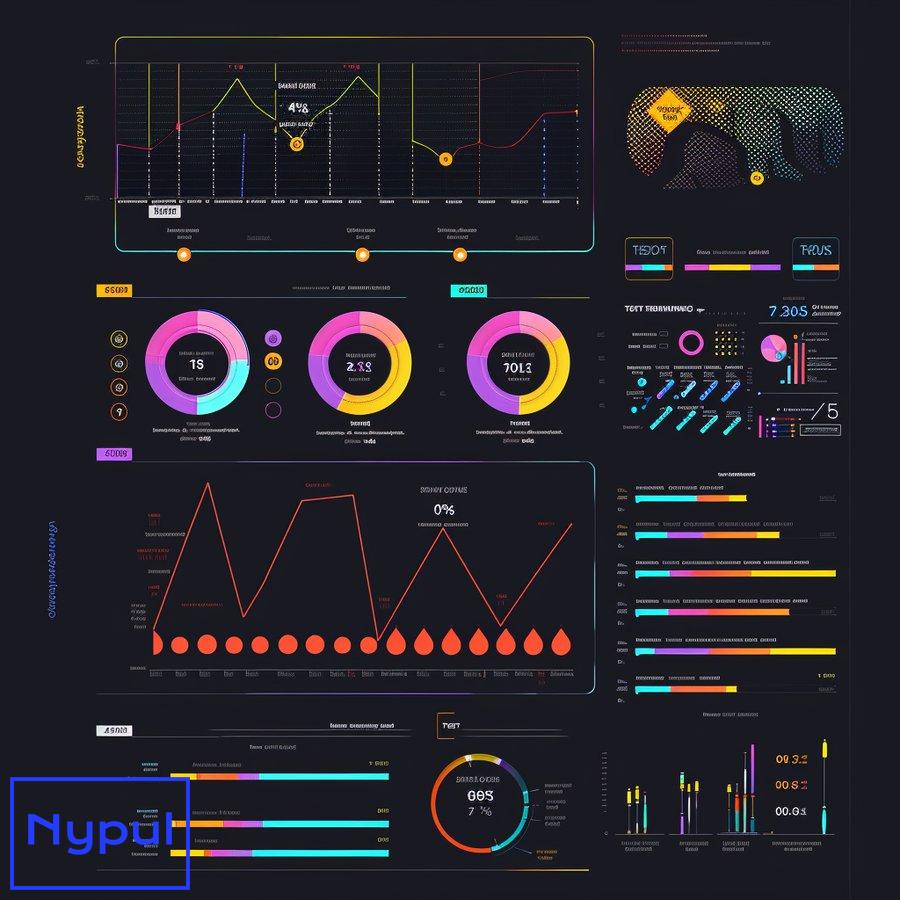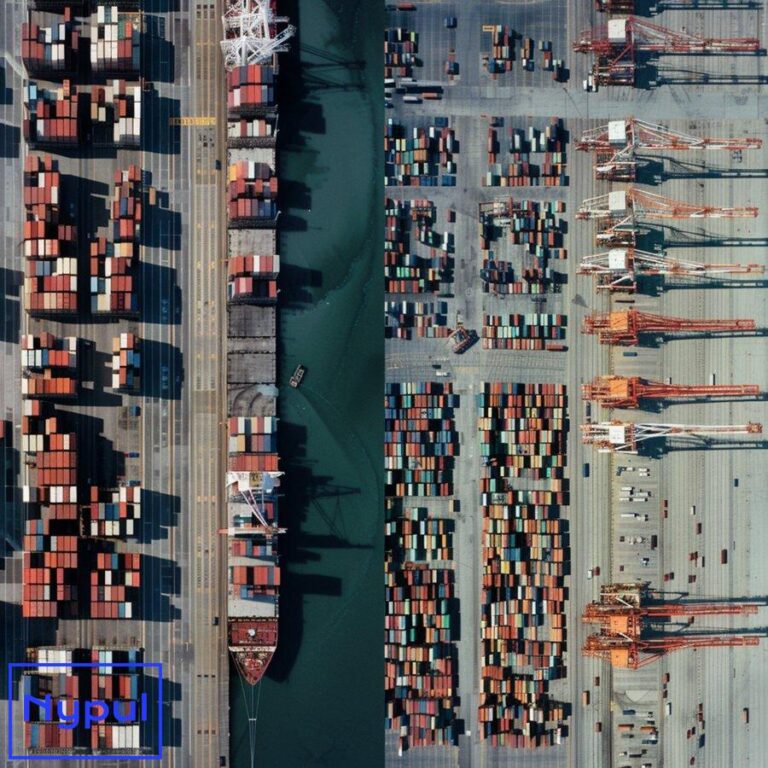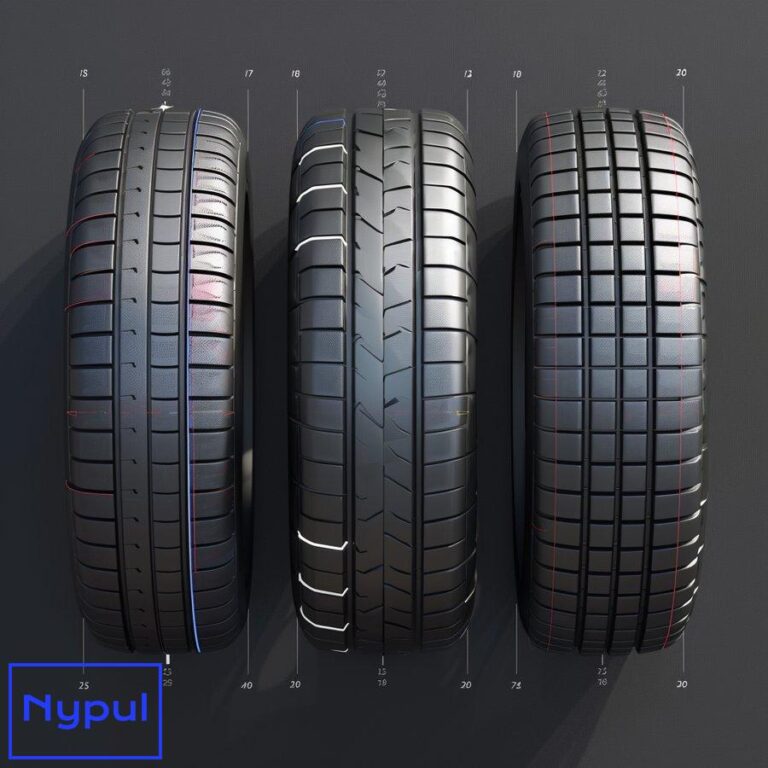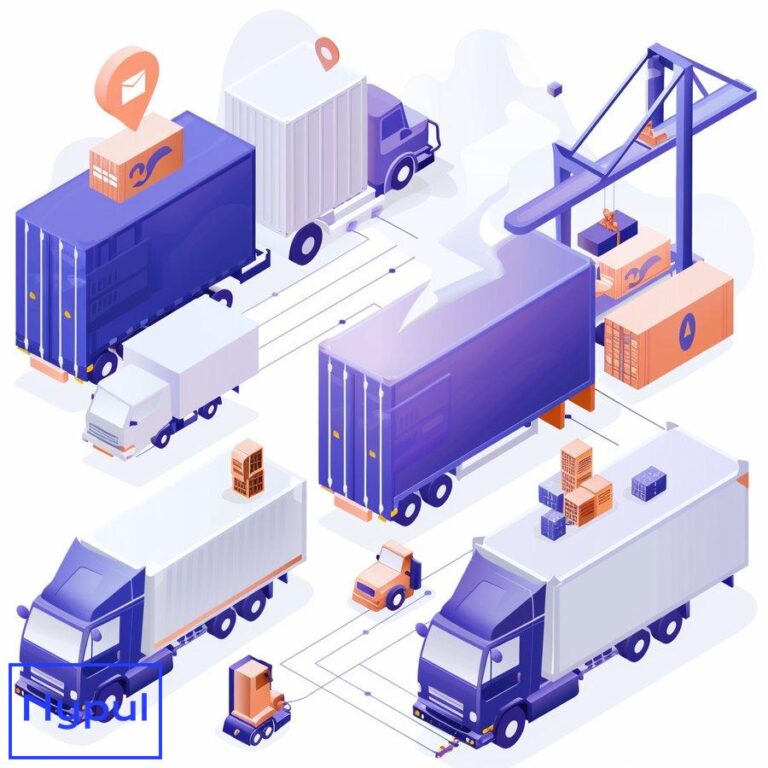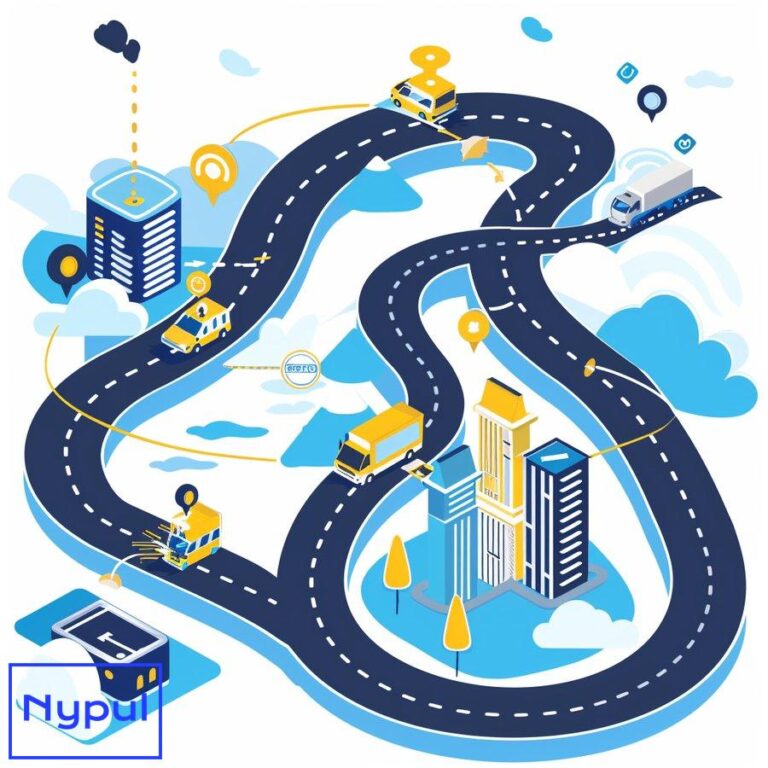What Is Real-Time Supply Chain Visibility in Logistics
What is Real-Time Supply Chain Visibility?
Real-time supply chain visibility refers to the ability to track and monitor goods, assets, and information as they move through the supply chain network, providing instant updates and insights. This comprehensive view encompasses every stage of the supply chain, from raw material sourcing to final product delivery.
Real-time supply chain visibility systems collect, process, and analyze data from various sources, including GPS trackers, IoT sensors, and enterprise software. These systems then present the information in an easily digestible format, often through dashboards or mobile applications, allowing stakeholders to make informed decisions quickly.

The concept of real-time visibility extends beyond mere location tracking. It includes:
Inventory Levels: Real-time updates on stock quantities at various points in the supply chain.
Order Status: Instant information on the progress of orders, from placement to fulfillment.
Transportation Details: Live updates on shipment locations, estimated arrival times, and potential delays.
Quality Control: Immediate alerts on any quality issues detected during production or transit.
Documentation: Access to digital versions of relevant paperwork, such as customs documents or certificates of origin.
Real-time supply chain visibility differs from traditional supply chain management in its immediacy and comprehensiveness. While traditional methods might rely on periodic updates and manual data entry, real-time systems provide continuous, automated information flows.
To illustrate the difference, consider this comparison:
| Aspect | Traditional Supply Chain Management | Real-Time Supply Chain Visibility |
|---|---|---|
| Data Update Frequency | Daily or weekly | Continuous, as events occur |
| Data Accuracy | Prone to human error | Highly accurate due to automation |
| Decision-Making Speed | Slower, based on historical data | Rapid, based on current information |
| Proactive Problem Solving | Limited | Enhanced ability to anticipate and prevent issues |
| Customer Updates | Periodic, often upon request | Continuous, often self-service |
Real-time supply chain visibility empowers businesses to respond swiftly to disruptions, optimize operations, and enhance customer satisfaction. As supply chains grow increasingly complex and global, the importance of real-time visibility continues to rise, making it a crucial component of modern logistics management.
Why is Real-Time Supply Chain Visibility Important in Logistics?
Real-time supply chain visibility plays a pivotal role in modern logistics, offering numerous advantages that can significantly impact a company’s efficiency, profitability, and customer satisfaction. Its importance stems from the evolving nature of global commerce and the increasing complexity of supply networks.
Risk Mitigation: Real-time visibility allows logistics managers to identify potential disruptions early. By monitoring weather patterns, traffic conditions, and geopolitical events, companies can anticipate delays and take preemptive action. This proactive approach minimizes the impact of unforeseen circumstances on the supply chain.

Inventory Optimization: With real-time data on stock levels across various locations, businesses can maintain optimal inventory levels. This reduces carrying costs and the risk of stockouts or overstocking. Companies can make informed decisions about replenishment, ensuring they have the right products in the right place at the right time.
Improved Decision Making: Access to real-time data enables faster, more accurate decision-making. Logistics managers can quickly assess situations and choose the best course of action based on current information rather than relying on outdated reports.
Enhanced Collaboration: Real-time visibility fosters better communication and collaboration among supply chain partners. When all stakeholders have access to the same up-to-date information, it becomes easier to coordinate activities and resolve issues collectively.
Regulatory Compliance: In industries with strict regulatory requirements, such as pharmaceuticals or food, real-time visibility helps ensure compliance. Companies can track temperature-sensitive goods throughout their journey and maintain a clear chain of custody, which is crucial for meeting regulatory standards.
Cost Reduction: By optimizing routes, reducing idle time, and minimizing errors, real-time visibility can lead to significant cost savings. Companies can identify inefficiencies in their supply chain and take steps to address them promptly.
Customer Satisfaction: In an era where customers expect fast, reliable service, real-time visibility allows companies to provide accurate delivery estimates and proactive updates. This transparency builds trust and enhances the overall customer experience.
Competitive Advantage: Companies that leverage real-time supply chain visibility can respond more quickly to market changes and customer demands. This agility can be a significant differentiator in competitive markets.
The importance of real-time supply chain visibility is further underscored by its impact on key performance indicators (KPIs) in logistics:
| KPI | Impact of Real-Time Visibility |
|---|---|
| On-Time Delivery Rate | Improves through better route planning and proactive problem-solving |
| Inventory Turnover | Increases due to optimized stock levels and reduced holding times |
| Order Accuracy | Enhances by reducing errors in picking and shipping |
| Transportation Costs | Decreases through optimized routing and load planning |
| Customer Satisfaction Score | Rises due to improved service and communication |
Real-time supply chain visibility is not just a technological advancement; it’s a strategic imperative for logistics companies aiming to thrive in today’s fast-paced, global marketplace. By providing a clear, instantaneous view of the entire supply chain, it enables businesses to operate more efficiently, respond more effectively to challenges, and deliver superior value to their customers.
What Are the Key Components of Real-Time Supply Chain Visibility?
Real-time supply chain visibility is a complex system comprised of several interconnected components. Each element plays a crucial role in collecting, processing, and disseminating information across the supply chain network. Understanding these key components is essential for implementing an effective real-time visibility solution.
Data Collection Technologies: The foundation of real-time visibility lies in the ability to gather data from various points in the supply chain. This component includes:
- GPS Trackers: Provide real-time location data for vehicles and shipments.
- IoT Sensors: Monitor conditions such as temperature, humidity, and shock for sensitive goods.
- RFID Tags: Enable automatic identification and tracking of items as they move through checkpoints.
- Barcode Scanners: Allow for quick and accurate data entry at various stages of the supply chain.
Data Integration Platform: This component serves as the central hub for all collected data. It must be capable of:
- Aggregating information from diverse sources and formats.
- Normalizing data to ensure consistency across different systems.
- Providing APIs for seamless integration with other business systems.
Real-Time Analytics Engine: Once data is collected and integrated, it needs to be analyzed to provide actionable insights. This component should:
- Process large volumes of data quickly.
- Identify patterns and anomalies.
- Generate alerts for potential issues or opportunities.
- Provide predictive analytics for future planning.
Visualization Tools: To make the data easily understandable, visualization tools are crucial. They should offer:
- Customizable dashboards for different user roles.
- Interactive maps for tracking shipments and assets.
- Graphical representations of key performance indicators.
- Mobile-friendly interfaces for on-the-go access.
Communication Systems: Effective real-time visibility requires rapid dissemination of information. This component includes:
- Automated alert systems for notifying relevant parties of critical events.
- Collaboration tools for stakeholders to discuss and resolve issues.
- Customer-facing portals for self-service tracking and updates.
Security and Compliance Measures: Given the sensitive nature of supply chain data, robust security is essential. This component should provide:
- End-to-end encryption for data in transit and at rest.
- Role-based access controls to ensure data is only accessible to authorized users.
- Audit trails for tracking data access and changes.
- Compliance features to meet industry-specific regulations.
Artificial Intelligence and Machine Learning: These advanced technologies enhance the capabilities of real-time visibility systems by:
- Predicting potential disruptions based on historical and real-time data.
- Optimizing routes and inventory levels automatically.
- Improving demand forecasting accuracy.
- Detecting anomalies that might indicate fraud or quality issues.
Scalable Cloud Infrastructure: To handle the vast amounts of data and ensure accessibility, a robust cloud infrastructure is necessary. It should offer:
- High availability and reliability to ensure continuous operation.
- Scalability to accommodate growing data volumes and user bases.
- Global distribution for low-latency access across different regions.
The integration of these components creates a comprehensive real-time supply chain visibility system. Here’s a table summarizing the key functions of each component:
| Component | Primary Function | Key Benefits |
|---|---|---|
| Data Collection Technologies | Gather real-time data from various sources | Provides accurate, up-to-date information |
| Data Integration Platform | Aggregate and normalize data from diverse systems | Ensures data consistency and accessibility |
| Real-Time Analytics Engine | Process data to generate insights and predictions | Enables informed decision-making |
| Visualization Tools | Present data in easily understandable formats | Facilitates quick comprehension of complex information |
| Communication Systems | Disseminate information and alerts | Ensures timely response to events |
| Security and Compliance Measures | Protect data and ensure regulatory compliance | Maintains trust and legal adherence |
| AI and Machine Learning | Enhance predictive capabilities and automation | Improves efficiency and accuracy of operations |
| Scalable Cloud Infrastructure | Provide reliable, accessible data storage and processing | Supports growth and global operations |
By leveraging these key components, businesses can create a robust real-time supply chain visibility system that provides comprehensive insights, enhances decision-making, and ultimately improves overall supply chain performance.
What Are the Benefits of Real-Time Supply Chain Visibility?
Real-time supply chain visibility offers a multitude of benefits that can transform logistics operations and drive significant improvements across various aspects of business performance. These advantages extend beyond mere operational efficiencies, impacting financial outcomes, customer relationships, and strategic decision-making.
Enhanced Operational Efficiency: Real-time visibility allows for the optimization of various processes within the supply chain:
- Route Optimization: By having access to real-time traffic and weather data, companies can adjust transportation routes dynamically, reducing fuel costs and improving delivery times.
- Warehouse Management: Real-time inventory data enables more efficient picking, packing, and restocking processes, minimizing idle time and maximizing space utilization.
- Labor Allocation: With visibility into upcoming shipments and current workloads, managers can allocate staff more effectively, reducing overtime costs and improving productivity.
Improved Inventory Management: Real-time visibility provides accurate, up-to-date information on inventory levels across the supply chain:
- Reduced Stockouts: Companies can anticipate low stock levels and replenish inventory proactively, minimizing lost sales opportunities.
- Decreased Excess Inventory: By having a clear view of demand patterns and current stock levels, businesses can avoid overstocking, reducing carrying costs and the risk of obsolescence.
- Enhanced Demand Forecasting: Real-time data on sales and inventory movements enables more accurate demand predictions, leading to better production and procurement planning.
Increased Customer Satisfaction: Real-time visibility allows companies to provide superior customer service:
- Accurate Delivery Estimates: With real-time tracking of shipments, businesses can provide customers with precise delivery times, reducing uncertainty and improving satisfaction.
- Proactive Issue Resolution: Companies can identify potential delays or problems early and take corrective action before they impact the customer.
- Self-Service Options: Customers can access real-time information about their orders, reducing the need for customer service inquiries and empowering customers with information.
Risk Mitigation and Resilience: Real-time visibility enhances a company’s ability to manage and mitigate risks:
- Early Warning System: By monitoring various data points in real-time, businesses can identify potential disruptions early and take preemptive action.
- Rapid Response: When issues do occur, real-time visibility allows for quick assessment and response, minimizing the impact on operations.
- Scenario Planning: With access to comprehensive real-time data, companies can develop and test various scenarios, improving their preparedness for future disruptions.
Financial Performance Improvement: The operational benefits of real-time visibility translate into financial advantages:
- Cost Reduction: Optimized operations lead to reduced transportation costs, lower inventory holding costs, and decreased labor expenses.
- Revenue Growth: Improved product availability and customer satisfaction can drive sales growth and customer retention.
- Working Capital Optimization: Better inventory management and more accurate demand forecasting can reduce the amount of capital tied up in inventory.
Enhanced Compliance and Sustainability: Real-time visibility supports regulatory compliance and sustainability initiatives:
- Traceability: Companies can maintain detailed records of product movements, crucial for industries with strict regulatory requirements.
- Carbon Footprint Reduction: By optimizing routes and reducing unnecessary transportation, businesses can lower their carbon emissions.
- Ethical Sourcing: Real-time visibility into supplier operations can help ensure compliance with ethical sourcing standards.
Strategic Decision-Making: Real-time visibility provides valuable insights that can inform strategic decisions:
- Market Responsiveness: Companies can quickly identify and respond to changes in demand or market conditions.
- Network Optimization: Analysis of real-time data can reveal opportunities for improving the overall supply chain network structure.
- Supplier Performance Management: Continuous monitoring of supplier performance enables better vendor selection and management.
To illustrate the quantitative impact of these benefits, consider the following table showing potential improvements in key performance indicators:
| Key Performance Indicator | Potential Improvement with Real-Time Visibility |
|---|---|
| On-Time Delivery Rate | 10-15% increase |
| Inventory Carrying Costs | 20-30% reduction |
| Transportation Costs | 8-12% reduction |
| Order Fulfillment Accuracy | 20-25% improvement |
| Customer Satisfaction Score | 15-20% increase |
| Supply Chain Cycle Time | 30-50% reduction |
These benefits collectively contribute to creating a more agile, efficient, and customer-centric supply chain. By leveraging real-time visibility, companies can not only improve their operational performance but also gain a significant competitive advantage in the marketplace. The ability to respond quickly to changes, optimize resources, and provide superior customer service positions businesses to thrive in today’s fast-paced and unpredictable business environment.
What Challenges Are Associated with Achieving Real-Time Supply Chain Visibility?
While the benefits of real-time supply chain visibility are substantial, implementing and maintaining such systems comes with its own set of challenges. These obstacles range from technological hurdles to organizational and industry-wide issues. Understanding these challenges is crucial for companies looking to successfully implement real-time visibility solutions.
Data Quality and Consistency: One of the primary challenges in achieving real-time supply chain visibility is ensuring the quality and consistency of data across various sources:
- Data Accuracy: Inaccurate or outdated data can lead to poor decision-making and erode trust in the system.
- Data Standardization: Different systems and partners may use varying data formats, making integration difficult.
- Data Completeness: Gaps in data collection can result in an incomplete picture of the supply chain.
Technology Integration: Integrating real-time visibility systems with existing infrastructure can be complex:
- Legacy Systems: Many companies still rely on older systems that may not be compatible with modern real-time visibility solutions.
- Multiple Platforms: Large organizations often use various software platforms across different departments, complicating integration efforts.
- API Management: Developing and maintaining APIs for seamless data exchange between systems can be challenging.
Cost of Implementation: Implementing real-time visibility solutions can require significant financial investment:
- Hardware Costs: Purchasing and installing sensors, trackers, and other data collection devices can be expensive, especially for large-scale operations.
- Software Expenses: Licensing fees for advanced analytics and visualization tools can be substantial.
- Training and Change Management: Educating staff and managing the organizational change associated with new systems adds to the overall cost.
Security and Privacy Concerns: As supply chain data becomes more detailed and accessible, security risks increase:
- Data Breaches: The centralization of sensitive supply chain data makes it an attractive target for cybercriminals.
- Intellectual Property Protection: Sharing detailed operational data with partners raises concerns about protecting proprietary information.
- Regulatory Compliance: Ensuring compliance with data protection regulations across different regions can be complex.
Scalability and Performance: As supply chains grow and data volumes increase, maintaining system performance becomes challenging:
- Data Processing Speed: Analyzing large volumes of real-time data requires significant computational power.
- System Responsiveness: Ensuring that the system remains responsive during peak usage periods can be difficult.
- Global Coverage: Providing consistent performance across different geographical regions presents technical challenges.
Partner Collaboration: Achieving end-to-end visibility often requires cooperation from various supply chain partners:
- Resistance to Sharing Data: Some partners may be reluctant to share detailed operational data due to competitive concerns.
- Technological Disparities: Partners may have varying levels of technological sophistication, making seamless integration challenging.
- Alignment of Objectives: Ensuring that all partners see the value in real-time visibility and are willing to invest in it can be difficult.
Change Management: Implementing real-time visibility often requires significant changes to existing processes and workflows:
- Resistance to Change: Employees may resist adopting new systems and processes, particularly if they perceive them as disruptive or threatening.
- Skill Gap: The workforce may lack the necessary skills to effectively use new technologies, requiring extensive training.
- Cultural Shift: Moving to a data-driven decision-making culture can be challenging for organizations accustomed to traditional methods.
Maintenance and Upgrades: Keeping real-Maintenance and Upgrades: Keeping real-time visibility systems operational and up-to-date is an ongoing challenge:
- System Maintenance: Regular updates and maintenance are necessary to ensure that the technology remains functional and secure.
- Upgrading Technology: As new technologies emerge, companies may need to invest in upgrades to stay competitive, which can be resource-intensive.
- Continuous Training: Ongoing training for employees is essential to keep pace with system changes and ensure effective use of new features.
Addressing these challenges requires a strategic approach that includes careful planning, investment in technology and training, and fostering a culture of collaboration and data sharing among supply chain partners. By recognizing and proactively managing these obstacles, companies can enhance their chances of successfully implementing real-time supply chain visibility solutions.
How Do Different Industries Implement Real-Time Supply Chain Visibility?
The implementation of real-time supply chain visibility varies significantly across different industries due to unique requirements, regulatory considerations, and operational complexities. Understanding how various sectors adopt these technologies can provide valuable insights for organizations looking to enhance their supply chain operations.
Retail Industry: In the retail sector, real-time visibility is crucial for managing inventory levels and ensuring product availability. Key implementation strategies include:

- RFID Technology: Retailers use RFID tags to track inventory in real-time, enabling accurate stock counts and reducing shrinkage.
- Point-of-Sale Integration: Data from sales transactions is integrated with inventory systems to provide real-time updates on stock levels.
- Customer Engagement: Retailers leverage visibility tools to provide customers with accurate information about product availability and delivery times through mobile apps and websites.
Manufacturing Industry: Manufacturers implement real-time visibility to optimize production processes and manage supply chain risks. Strategies include:
- IoT Sensors: Sensors are used on machinery and equipment to monitor performance and detect issues before they lead to downtime.
- Supply Chain Control Towers: Many manufacturers establish control towers that provide centralized visibility into the entire supply chain, enabling better coordination among suppliers, production facilities, and logistics providers.
- Predictive Analytics: Advanced analytics tools help manufacturers forecast demand fluctuations, allowing them to adjust production schedules accordingly.
Pharmaceutical Industry: Given the stringent regulatory requirements in pharmaceuticals, real-time visibility is critical for compliance and safety. Implementation strategies include:
- Temperature Monitoring: IoT sensors monitor temperature-sensitive products throughout the supply chain, ensuring compliance with regulations regarding storage conditions.
- Blockchain Technology: Some pharmaceutical companies are exploring blockchain for secure tracking of drug provenance, enhancing traceability and reducing counterfeit risks.
- Automated Reporting: Real-time data collection facilitates automated reporting for regulatory compliance, reducing administrative burdens.
Food and Beverage Industry: In this industry, real-time visibility is essential for ensuring product quality and safety. Key implementation methods include:
- Cold Chain Monitoring: Sensors track temperature and humidity levels during transportation to ensure food safety standards are met.
- Traceability Solutions: Companies implement traceability systems that allow them to track products from farm to table, enhancing transparency for consumers.
- Inventory Management Systems: Real-time data helps manage perishable inventory more effectively, reducing waste.
Automotive Industry: Automotive manufacturers rely on real-time visibility for managing complex supply chains involving numerous suppliers. Implementation strategies include:
- Supplier Collaboration Platforms: Manufacturers use platforms that enable real-time communication with suppliers regarding inventory levels and production schedules.
- Digital Twins: Some companies create digital twins of their supply chains to simulate scenarios and optimize operations based on real-time data.
- Logistics Optimization Tools: Advanced analytics tools help automotive firms optimize transportation routes and schedules based on real-time traffic data.
To summarize how different industries approach the implementation of real-time supply chain visibility, consider the following table:
| Industry | Key Implementation Strategies |
|---|---|
| Retail | RFID technology, POS integration, customer engagement tools |
| Manufacturing | IoT sensors, control towers, predictive analytics |
| Pharmaceuticals | Temperature monitoring, blockchain technology, automated reporting |
| Food & Beverage | Cold chain monitoring, traceability solutions, inventory management |
| Automotive | Supplier collaboration platforms, digital twins, logistics optimization tools |
Each industry faces unique challenges but also benefits significantly from adopting real-time supply chain visibility solutions. By tailoring their approaches to meet specific needs and leveraging industry best practices, organizations can enhance their operational efficiency and responsiveness.
What Technologies Enable Real-Time Supply Chain Visibility?
The foundation of real-time supply chain visibility lies in various technologies that facilitate data collection, integration, analysis, and dissemination. Understanding these technologies is essential for organizations looking to implement effective visibility solutions.
Internet of Things (IoT): IoT devices play a crucial role in gathering real-time data from various points in the supply chain. These devices include:
- Sensors: Used for monitoring environmental conditions (temperature, humidity) during transportation or storage.
- GPS Trackers: Provide location data for shipments in transit.
- Smart Devices: Such as connected forklifts or automated guided vehicles that report operational status in real time.
IoT technology enables continuous monitoring of assets throughout the supply chain, providing critical insights into performance and conditions.
Cloud Computing: Cloud-based platforms facilitate data storage, processing, and accessibility across the supply chain. Key benefits include:
- Scalability: Organizations can easily scale their infrastructure as data volumes grow.
- Accessibility: Stakeholders can access data from anywhere with an internet connection.
- Cost Efficiency: Reduces the need for expensive on-premises hardware by leveraging shared resources.
Cloud computing supports seamless integration between various systems involved in the supply chain.
Big Data Analytics: The ability to analyze large volumes of data in real time is essential for deriving actionable insights. Technologies involved include:
- Data Mining Tools: Identify patterns or trends within large datasets that can inform decision-making.
- Predictive Analytics Software: Uses historical data combined with real-time inputs to forecast future demand or potential disruptions.
- Machine Learning Algorithms: Continuously improve predictions based on new data inputs over time.
Big data analytics enhances decision-making capabilities by providing deeper insights into supply chain dynamics.
Artificial Intelligence (AI): AI technologies augment the capabilities of visibility systems by enabling advanced analytics and automation. Key applications include:
- Chatbots for Customer Service: Provide instant responses to customer inquiries regarding order status or delivery times.
- Automated Decision-Making Systems: Optimize routing or inventory management based on real-time conditions without human intervention.
- Anomaly Detection Systems: Identify unusual patterns that may indicate potential issues such as fraud or equipment failure.
AI enhances efficiency by automating routine tasks while providing valuable insights into complex scenarios.
Blockchain Technology: Blockchain offers a secure method for tracking transactions across the supply chain. Its key features include:
- Immutable Record Keeping: Provides a tamper-proof record of all transactions related to products as they move through the supply chain.
- Enhanced Traceability: Allows stakeholders to trace products back through every step of their journey quickly.
- Smart Contracts: Automate agreements between parties based on predefined conditions being met (e.g., automatic payment upon delivery).
Blockchain enhances transparency and trust among supply chain partners by providing a reliable method for recording transactions.
To summarize the enabling technologies for real-time supply chain visibility, consider the following table:
| Technology | Key Features | Benefits |
|---|---|---|
| IoT | Sensors, GPS trackers | Continuous monitoring of assets |
| Cloud Computing | Scalability, accessibility | Cost-efficient infrastructure |
| Big Data Analytics | Data mining tools | Enhanced decision-making capabilities |
| Artificial Intelligence | Chatbots, automated systems | Improved efficiency through automation |
| Blockchain | Immutable records | Enhanced traceability and trust |
These technologies work together to create a comprehensive ecosystem that supports effective real-time supply chain visibility. By leveraging these advancements strategically, organizations can enhance their operational performance while responding swiftly to market demands.
How Can Real-Time Supply Chain Visibility Improve Customer Satisfaction?

Customer satisfaction is a critical metric for businesses across industries. Real-time supply chain visibility directly impacts this metric by enhancing service delivery through improved transparency, responsiveness, and reliability. The following points illustrate how organizations can leverage visibility solutions to elevate customer experiences.
Accurate Order Tracking: Customers increasingly expect transparency regarding their orders. Real-time visibility allows businesses to provide precise tracking information at every stage of the delivery process:
- Customers can receive updates on shipment status via mobile apps or websites.
- Notifications regarding delays or changes in delivery times can be communicated proactively.
This level of transparency builds trust with customers who appreciate being informed about their orders’ progress.
Faster Response Times to Inquiries or Issues: With access to up-to-date information about inventory levels and shipment statuses:
- Customer service representatives can quickly address inquiries without needing extensive research or hold times.
- Businesses can proactively resolve issues before they escalate into customer complaints or dissatisfaction.
Rapid response capabilities enhance overall customer experience by minimizing frustration associated with delays or uncertainties.
Personalized Customer Experiences: Real-time data enables businesses to tailor offerings based on individual customer preferences:
- Companies can analyze purchasing patterns in conjunction with current stock levels to recommend relevant products effectively.
- Personalized communication regarding promotions or restocks becomes possible when businesses understand customer behavior better.
Tailored experiences foster loyalty as customers feel valued by brands that cater specifically to their needs.
Improved Delivery Performance Metrics (On-Time Delivery): Real-time visibility allows companies to optimize logistics operations effectively:
- Route optimization based on live traffic conditions ensures timely deliveries while minimizing costs associated with delays.
- Proactive identification of potential disruptions allows businesses to adjust plans accordingly before they impact customers negatively.
Enhancing delivery performance metrics directly correlates with increased customer satisfaction as timely deliveries build reliability perceptions among consumers.
To illustrate how improvements in key performance indicators (KPIs) translate into enhanced customer satisfaction levels:
| KPI | Improvement Impact on Customer Satisfaction |
|---|---|
| On-Time Delivery Rate | Higher satisfaction due to reliability |
| Order Fulfillment Accuracy | Reduced errors lead to fewer complaints |
| Communication Timeliness | Proactive updates enhance trustworthiness |
In summary, investing in real-time supply chain visibility not only streamlines operations but also significantly enhances customer satisfaction levels. By prioritizing transparency throughout every step—from order placement through delivery—organizations position themselves favorably within competitive markets where exceptional service is paramount.
